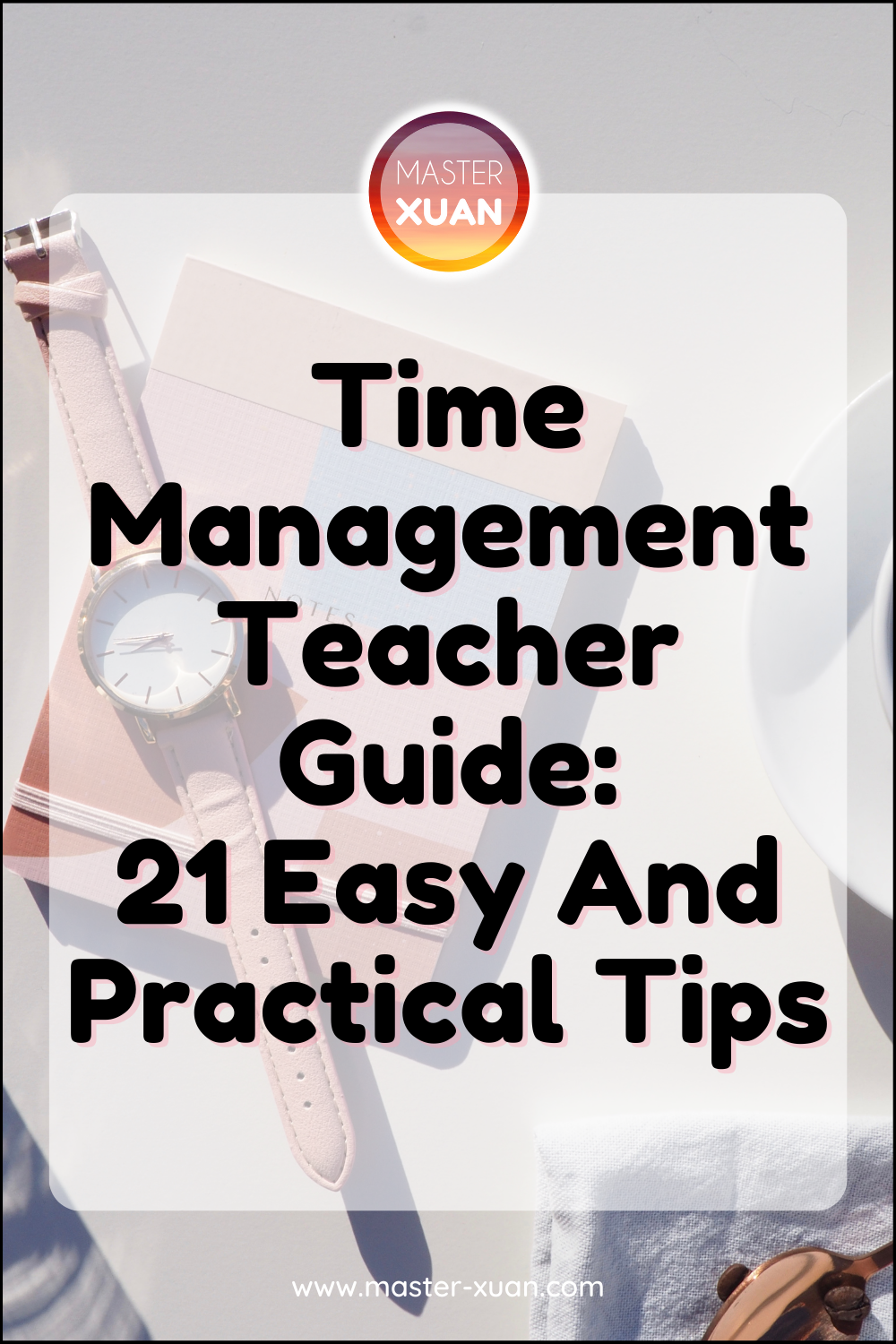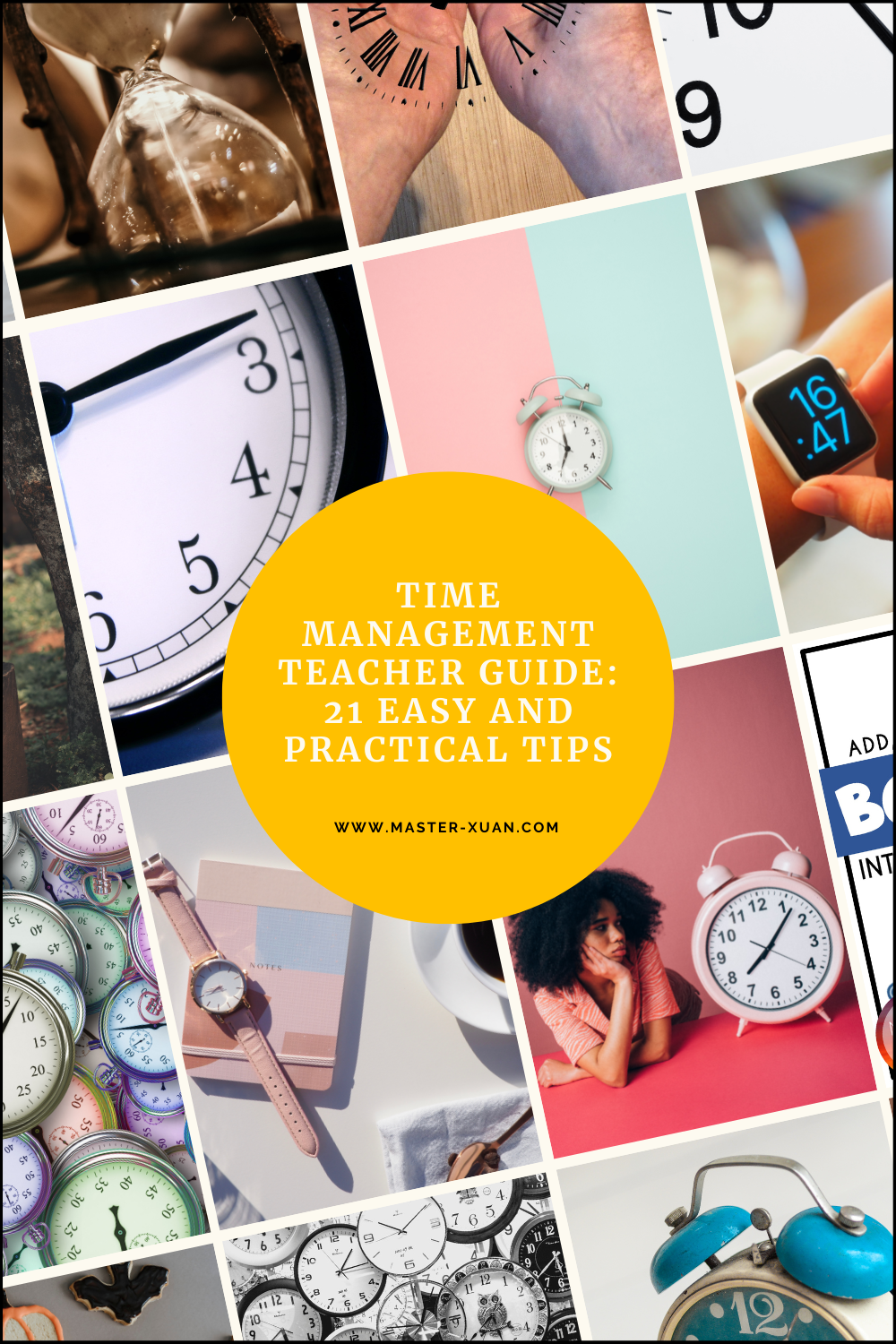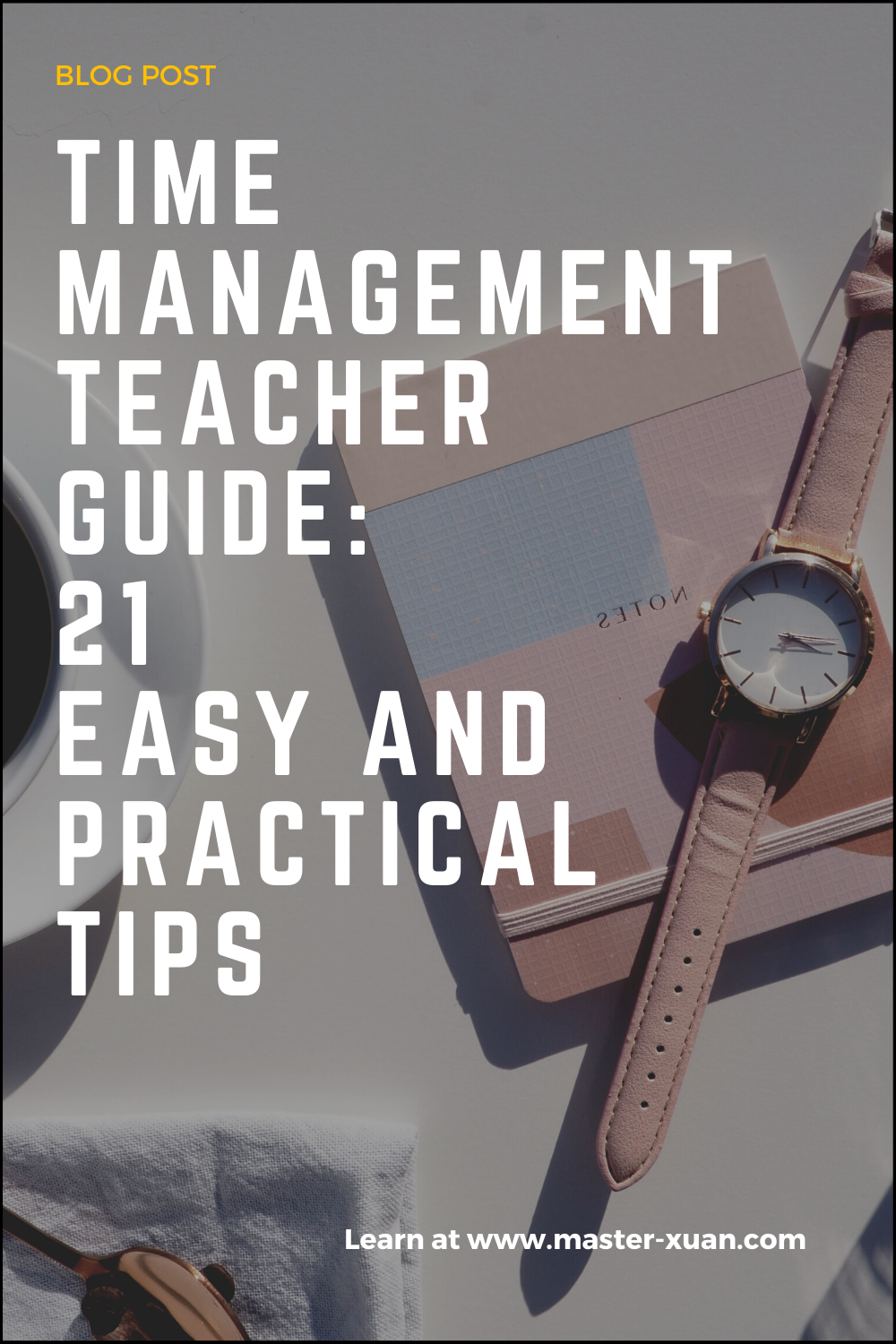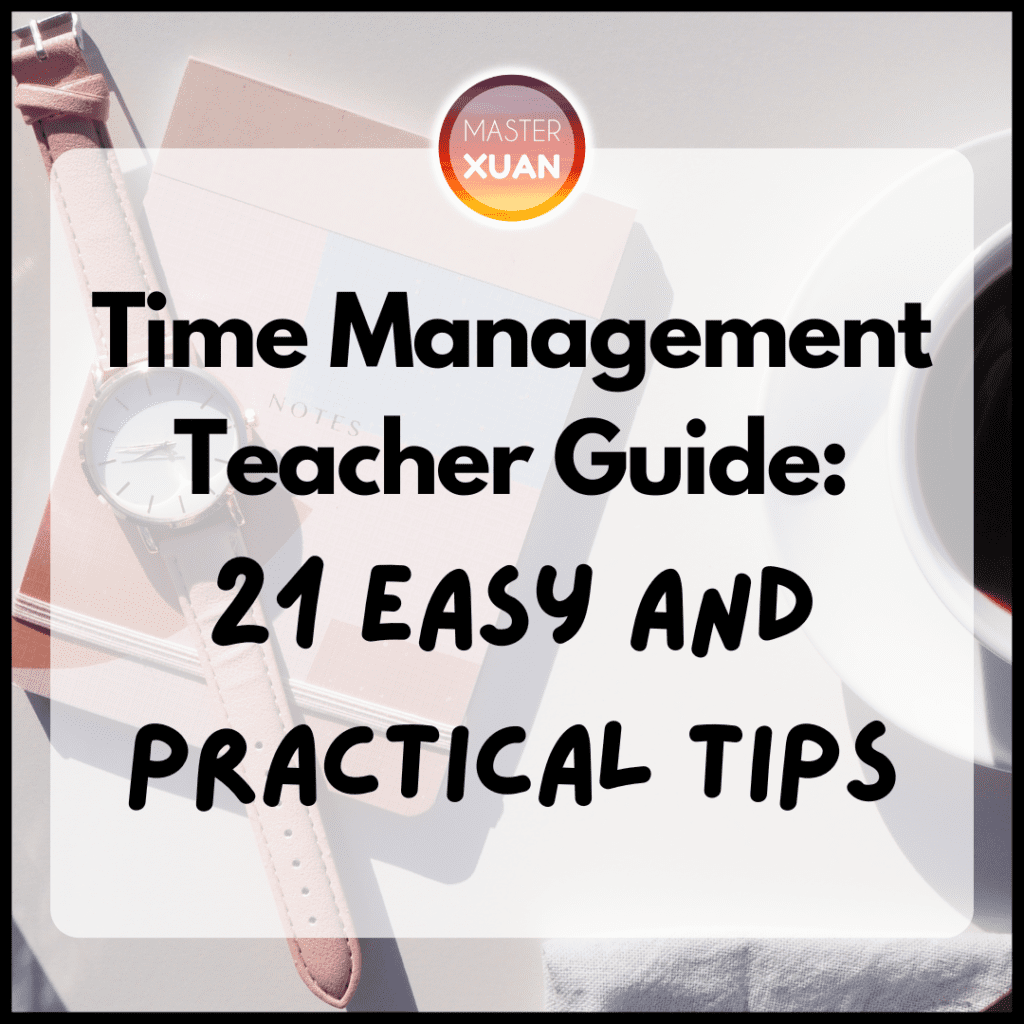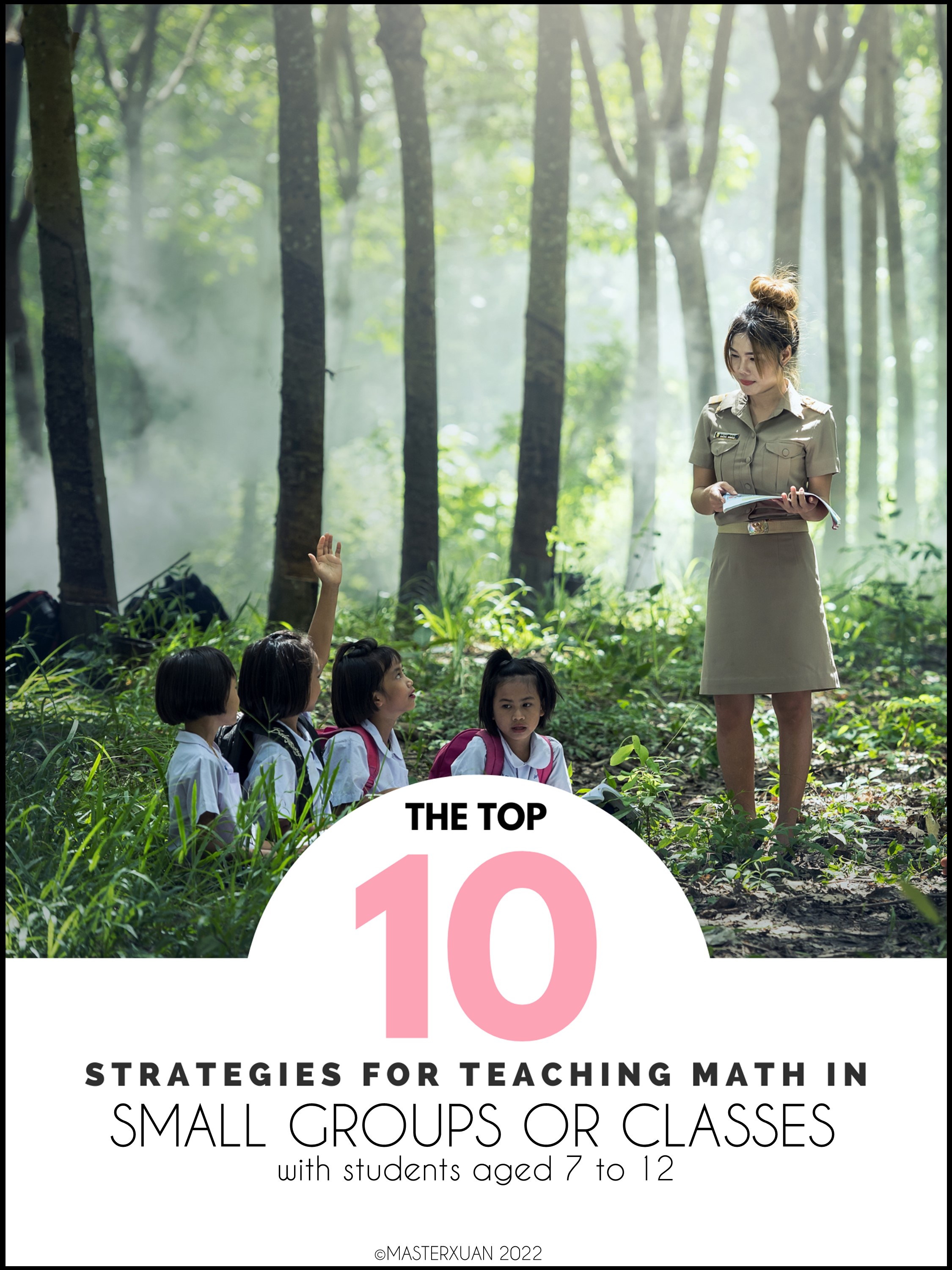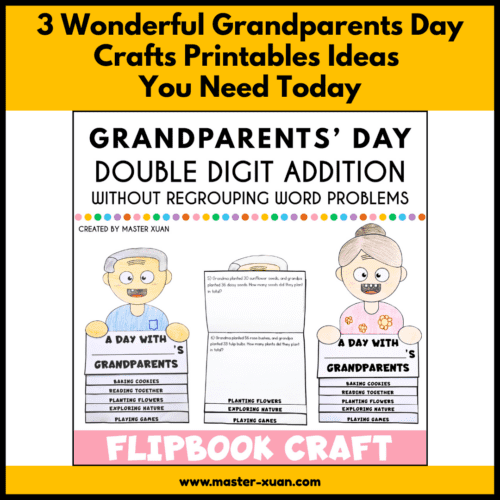If you are looking for a time management teacher guide version, then you’ve come to the right place. I’m going to show you how to manage your time better than ever before.
This article will give you time management tips elementary teachers can use to become better time managers so that they can get more done in less time.
The post is split into 2 parts: time management strategies in the classroom and time management techniques and practices you can use in daily life.
This blog post will answer the following questions about time management:
- what does time management mean?
- why time management skills are important?
- how does time management help?
- how to manage your time as a teacher?
What time management means?
Time management means “the practice of using the time that you have available in a useful and effective way, especially in your work” based on the Cambridge dictionary.
Definitions from Oxford Languages define it as “the ability to use one’s time effectively or productively, especially at work.”
Here’s my understanding of the term:
Time management is the process of efficiently planning time spent between different activities with the goal that time were not wasted and tasks are completed on time.
Why time management skills are important?
Time management is an important skill that everyone needs to master in order to succeed at school, at work, and in life.
Because time is finite and we have so many things to do. Learning this skill enables us to complete more tasks even when we have deadlines to follow.
Other than that, here are some more reasons how time management helps.
- Less stressful
- Be more efficient and productive
- Increase focus
- Able to grab opportunities that come our way
- Accomplish our goals and ambition in life
- Spend more time on things and people that matter
After knowing why time management is so important, it is time for the tips!
Time Management Teacher Guide
Here are the 23 teachers’ time management tips.
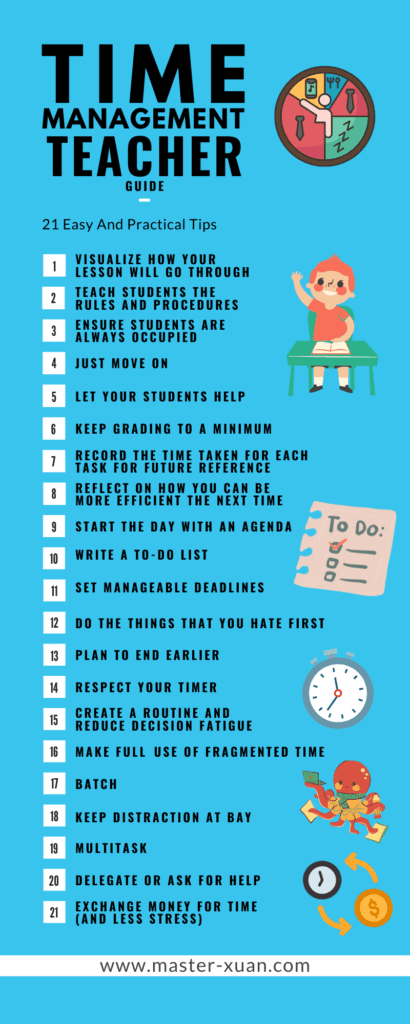
A) Time Management Tips For Teachers In The Classroom
The first part of the time management teacher guide: 8 tips for time management in teaching lessons or managing time in the classroom.
1) Visualize how your lesson will go through
Give an approximate duration of each activity.
Rehearsal can help make your lesson more efficient as you can forsee the problems and come up with the solution before they actually happen.
It also helps to save time during the lesson as you already know what you planned to do and how to execute it.
Have a plan or something in mind for students who are working at a slower or faster rate.
Releated Read: 3 Easy & Simple Ways To Reduce Stress When Teaching In Small Groups
2) Teach students the rules and procedures
Ensure time is not wasted cause students don’t know the next task or activities to do.
For example:
- What should they do if they don’t know how to do certain questions?
- My way: I ask my students to skip the questions they don’t know first and I’ll teach them when it’s their turn.
- What happens if they finish the activities earlier?
- My way: move on to the next activity or take a brain break
3) Ensure students are always occupied
I hate it when students mindlessly wait for me when I’m teaching another student. Cause somehow, it feels like it was my fault that they wasted their precious learning time.
Solution 1: Refer to tip #2
Solution 2: Prepare students with more than enough activities or worksheets.
4) Just move on
- For you:
If you are stuck on a specific task (that wouldn’t stop you from continuing to the next step), consider moving on to another task. Come back later and who knows, you may “unblock” it.
Did something wrong in class today? Don’t wallow in it for too long.
Tomorrow is another new day. Move on.
- For students:
Some students may have difficulty learning certain topics or questions. It will be not beneficial for the child if you don’t move on to teaching other topics.
For example, students may not be proficient in their multiplication sums even after the number of lessons scheduled for them to learn.
Instead of continuing to spend many lessons practicing that particular skill, consider just allocating a certain time per lesson practicing them while moving on to another skill.
Furthermore, they may revisit the skill when learning other math topics.
So be hopeful that they will learn it one day (even when you lose all hope at the moment).
As they take time to digest the math skills, you will have to ensure they flourish in some other ways too.
5) Let your students help
There are a few tasks that your students may be happy to help you with.
For example, wiping the whiteboard, decorating the board, passing the worksheets, collecting items, marking, and teaching other students.
Participating in these activities might just make them feel part of a community or feel special.
And at the same time, save you some classroom time so that you can spend more time teaching other students.
6) Keep grading to a minimum
Solution 1: Use digital
Use boom cards, easel, google forms or other self-checking programs that will tell students whether they got it right or not. Not only do you have one less thing to do (marking), students also get to enjoy instant feedback.
Solution 2: Use self-checking printables
Use worksheets, printables or activities that are self-grading to save you tons of time.
For example, a scavenger hunt that shows the previous answer and the current question. If they can’t find an answer to their question, they know they are wrong and will need to redo it.

Solution 3: Use partners
Assign partners to students. Ask them to exchange their work and mark for each other.
Some discussion can happen here to encourage peer learning.
Solution 4: Self-grading
Show the answer and let them mark themselves.
7) Record the time taken for each task for future reference
Compare the time taken with the planned approximate duration of each activity.
Now you know the real-time taken to complete it (though the activity time do change with different groups of students). You can plan better the next time.
8) Reflect on how you can be more efficient the next time
Like playing a game, we get faster or better in the second round. But that is because we learned from past experiences.
Take some moment to reflect on what can we do to save more time or be more efficient and effective.
Make adjustments to your current plan or future plans.
Write it down so you don’t forget it.
Take action!
By reflecting on what you have done each day, as well as what is coming up on your weekly or termly to-do lists, you’ll start feeling more in control of your time and what you can achieve.
B) Time Management For The Teacher
This is the second part of the time management teacher guide: 15 time management tips that you can use in daily life.
9) Start the day with an agenda
Start each day with an agenda. For instance, write the 3 most urgent or important task that needs to be completed the next day.
This way, when you start the day, you don’t have to waste time thinking about what to do. Instead, you can start your engine at full steam right away, saving some precious time.
Furthermore, it also helps you avoid getting distracted by unimportant tasks.
10) Write a to-do list
Writing down what you need to do will save you time trying to think about what still needs to be done and what you have decided on previously.
In addition, when you record it down, you are actually quantifying the number of things you need to do.
No longer do you have the vague feeling that there are lots of things to be done (even though it might be true). Sometimes you will get overwhelmed because of the feeling of being too busy.
So, by listing it down, you have a concrete idea of what needs to be done and wouldn’t remain standstill due to being overwhelmed.
While making the list, prioritize tasks by labeling them.
Think about what’s most important and urgent.
Then, make sure you do them first.
Once done, scratch off the items on the to-do list. Doing so will give you a sense of accomplishment and help you feel better about getting those things done.
A positive cycle/habit is created!
11) Set manageable deadlines
Now that you have a to-do list, it is time to check if the duration allocated to them is reasonable or manageable.
If you have deadlines that are tight and you can’t change them for whatever reasons, then allocate more time for them. You need to be strict in scheduling or canceling tasks that will impede your progress on that particular task.
Note: don’t fret if you can’t put a date on all the tasks. Not all tasks need to have deadlines.
Just remember to schedule some me-time in between to prevent burnout!
12) Do the things that you hate first
You may “waste” time doing unimportant tasks when you are avoiding the things that you hate.
If you keep what you hate-to-do-but-need-to-do last on the list, you will more than likely procrastinate further.
So clear it first.
Furthermore, with the stuff that you enjoyed dangling in front of you, you will be more motivated to finish the hated task.
Save the best for the last as a reward.
Give yourself a pep talk or start doing them on days when you are of a high energy level.
13) Plan to end earlier
End earlier than you should so that you have some time to make a nice, unruffled ending.
You know yourself the best. How long does it takes from the time you know it should end till the time you really end?
Set an alarm to remind you 2-5 minutes earlier so you had time to wrap up whatever you needed to.
Here’s an example:
If you are supposed to go home at 3 p.m., start preparing 2 minutes in advance. When you close your laptop and put away the papers, it is already 3 p.m.
But if you are too early? Take the time to reflect and prepare for the next day!
14) Respect your timer
If you say you are going to scroll through your social media for just 15 minutes and even set a timer for it, stick to it!
Train yourself to respect it instead of ignoring it.
I do understand that sometimes it is necessary to run overtime.
Maybe cause you finally get the ball rolling and if you don’t continue doing it, you will lose the mojo. Totally forgivable.
However, don’t make it a habit.
Don’t let the snooze button become your accomplice.
For most of the time, learn to put down whatever stuff you are doing like students putting down their pens when the time is up.
15) Create a routine and reduce decision fatigue
When you know what to do each day, it saves you time thinking and planning.
But on a personal level, do you spend excessive time thinking about what to wear for the day?
Then consider imitating Steve Jobs. Steve Jobs used to wear the same outfit every day in order to save time and reduce decision fatigue.
Or consider a color code every day (you can ask your students to guess the pattern).
But if you prefer to have a variety of styles or more, then prepare in advance.
Have a system to decide what to wear in split seconds.
For instance, have a set of clothes that you wear when it is rainy or hot. Or ready a few paired outfits prepared and use a spinner to decide what to wear.
Alternatively, check your auspicious color for that day based on your horoscope to decide your color code.
16) Make full Use of fragmented time
Here are some examples of fragmented time:
- Commuting on public transport
- Waiting (for lift, food orders, traffic lights, etc.)
- Walking to places
If you can use your phones during this period of time, use them to write a blog post, write down your to-do list, and hear audiobooks or podcasts. I wrote parts of this article while commuting on a train using my mobile phone.
If you can’t use your phone or if it is too short a period of time to use your phone, use it to think instead (your brain is your supercomputer!).
For example, I use the time to think of new products, plan my days, reflect on my day, and reiterate affirmations.
But while you make full use of all your time doing “serious” work, it is perfectly fine to use it for relaxation too. Take the time to watch videos, play a game, scroll through social media or simply observe the surroundings.
17) Batch
Have you heard of the buzzword: batching?
Basically, it means doing the same tasks in one go. The reasoning is your brain wouldn’t need to switch gears and it will be more efficient that way.
You can use the Pomodoro Technique or the time chunking method. Basically, this means focusing on doing the task for a specific period of time (20-30 minutes), then rest for 5 minutes. Repeat the process.
18) Keep distraction at bay
If needed, close your door, and place a sign of do not disturb to let others know you are busy. This way, you can totally focus on the task on hand, which means you will be more efficient!
If distraction comes from your phone, switch it off or charge your phone while telling yourself that it is not good to use it while charging.
19) Multitask
Yes, I know the saying that we technically aren’t productive when multitasking.
But we also can’t deny that some tasks on hand don’t really need our full focus.
So save or steal some time when doing the mundane tasks by multitasking!
For example, we can hear audiobooks when doing exercises, cooking, or housework.
We can start tasks that require some loading time first and/or do connected tasks.
For example, I’ll continue teaching students while the worksheets are getting printed. After some time when every student are doing their work, I will walk to the pantry to refill my cup, then on the way back, collect the worksheets.
Imagine the time I save. Instead of walking out of my classroom and along the same pathway 2 times (taking the worksheets and refilling my cup), I reduce it to only 1 trip.
In addition, I do not need to stand at the printer and wait for it to print (of course you can do that if you need a break).
20) Delegate or ask for help
If you have difficulty with the task on hand, ask for help! You can ask your admin, fellow teacher, mentor, technician, friends, and family.
Don’t waste time thinking you have to fix it yourself.
What might cost you 10 minutes may just cost someone else 1 minute.
Ask yourself, do I really need to settle this by myself?
Remember, there is no shame in asking for help.
21) Exchange money for time (and less stress)
As the saying goes, time is money.
Since time = money, you can always exchange money for more time!
Sometimes the exchange rate is so low that you get to save so much time for the money exchanged.
To have a clearer idea, first, calculate how much your hourly wages are. Then see if the time needed to complete the task is worth it.
For example, buy math resources instead of creating them yourself.
Here’s the math:
- Hourly wages = $25
- Time is taken to create a quality piece of resource = 6 hours
- Price of the resource = 6 x $25 = $150.
- The price you can get online: $5
- You save 30 times energy (since time and money are forms of energy)
The hours of time you spend creating might be better spent elsewhere.
If you have a side hustle, would you be able to earn more than $5 and save $145?
Or think it this way, do the time you spend with your family and friends or doing the stuff that you love worth that extra expenditure of $5?
In exchange for a small fee, you could save yourself hours and hours of time.
Furthermore, be the savvy buyer and buy bundles so that you get to exchange more time for a lesser price!
In addition, remember that your money is not only buying time, it is also buying a less stressful teaching journey!
Related Read: Save Money And Time On Math Resources In 7 Ways
Conclusion
I hope you found this Time Management Teacher Guide helpful! To get notifications for a great article like this, join my newsletter today!
One solution is to check out the resources at my TpT shop to save you time and energy prepping tasks for your students.
Here’s a summary of the Time Management Teacher Guide:

Here are some pins that you can save to bookmark this post: Time Management Teacher Guide: 21 Easy And Practical Tips. Save them to your Pinterest Board now! ↓
